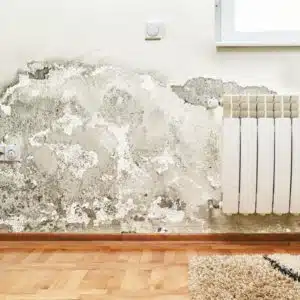You have probably found this blog post because you have damp, right? But maybe you’re not totally clued in on the various types or how to deal with them.
So, let’s dive into the nitty-gritty of the three most common damp types today, so you can handle them like a pro.
In your house, you’ll likely run into condensation damp, rising damp, and penetrating damp. Each one’s got its own reasons for showing up and needs a specific fix to kick it to the curb.
Condensation damp
Condensation occurs damp occurs when the air outside is cooler than the air inside. This difference in temperature causes the inside air to condense and form water droplets. These are often seen on windows but can also appear on walls.
The levels of moisture in a room will increase the likelihood of condensation happening. For example, the more moisture that a room has the more likely it is that condensation will form in it. Due to this factor, condensation damp is most commonly found in rooms such as kitchens, bathrooms, rooms where laundry is drying as well as rooms where people sleep.
We mentioned earlier that you can spot condensation via water droplets forming on windows and walls, but condensation damp can also create dark mould spots in places such as around window openings. If left unattended, this type of mould can damage paintwork, plaster and window frames. More importantly, though, the mould that grows is harmful to respiratory health and should be dealt with as soon as possible.
It is in your best interest to try and prevent condensation damp from forming in the first place. The best way to do this is by ensuring that there is good ventilation throughout your home.
Ideas for ventilation:
- Most modern houses now have what is known as ‘trickle vents’ installed at the top of their windows. These type of vents allows for a small amount of background ventilation with the slip off a switch.
- Another thing modern windows usually have is an option to allow you to ‘lock the window open’ in such a way that air is still able to come in. Similarly to the trickle vents, this will allow further ventilation whilst allowing you to secure your home.
- Using extractor fans in your kitchen and/or bathrooms will make a big difference. Make sure to run the fan for at least five mins after you have finishing cooking/bathing. If you have a bathroom or en suite that doesn’t have an external window but has a shower and/or bath, it may benefit from having a continuous fan installed. This type of fan will constantly work at a low speed and volume to reduce moisture, and will increase when the light is switched on.
Another way to try and avoid condensation damp is to avoid extreme temperature fluctuation. For example, in the Winter months it may be more beneficial to have your heating set to a consistent temperature when you are home, such as 18°C for example, and then drop it down to 15°C at night. Having this small fluctuation in temperature over several hours instead of being off or on quickly could be beneficial in the fight against condensation.
We also recommend using a dehumidifier as well as wiping away the water droplets as they form.
Removal of unsightly mould
Once you have fixed the cause of the condensation damp, you can then remove the unsightly mould.
The first thing you will need to do is use a chemical treatment to remove and kill the mould. We recommend using one that contains low toxicity ingredients and has high antimicrobic activity. For information, please see our previous blog post, ‘how to remove and prevent mould.’.
After the mould has been removed, you could use a product such as VC175 – a powerful, long-lasting mould and algae killer. Simply add a few drops to a wide range of products such as paint, timber stains, textured coatings, grout, mortar and adhesives to help prevent the reformation of mould and mildew.
If after using the above tips you are still having problems and are unsure of how to proceed, then an RICS accredited chartered building surveyor can conduct a damp inspection for you to uncover the issues and suggest a suitable course of action for you.
Rising damp
Rising damp is most likely the type of damp you have most commonly heard of but maybe are not familiar with the specifics of it. This type of damp occurs when water transfers into a building from the ground, usually carpet. It is more commonly found in older homes such as those built before 1875. It was around this time that regulations were put into place that would require a damp proof course and damp proof membrane to be installed in every house in the UK to help water-proof homes and stop water from coming in.
If this type of damp is found in a home built after this time, it is usually because there is a fault with one (or both) of these things.
The key signs to look out for with this type of damp include things such as; staining on walls, peeling and/or blistering paint, tide marks on walls, damage to skirting boards and an unpleasant musty odour.
This type of damp is very serious and we recommend consulting an RICS registered chartered building surveyor to establish the cause of the damp and help you find a suitable solution.
To help prevent rising damp:
- Before purchasing a house, we recommend you try and find out if it has a damp proof course and membrane installed. If your house has had a chemically injected damp proof membrane installed, it’s important to check the effectiveness of it and try to establish if an insurance backed guarantee is included.
- Make sure that the level of garden soil that is directly next to the house does not rise any higher than the level of the damp-proof barriers.
- Make sure that all the guttering is well designed and maintained and does not allow the ground to become saturated.
Treatment for rising damp might include things such as; repairing the existing damp-proof courses, installing a new damp-proof course or perhaps just increasing the ventilation to the home. Take a look at ‘ideas for ventilation’ above.
You may find in older homes that do not have damp-proof courses (or are less substantial ones), that modern renovations such as plastering and/or insulation can actually exacerbate damp issues by reducing the ventilation of the building. So we really recommend you get advice from a professional before investing time and money into renovation work that may well be your undoing.
Penetration damp
This type of damp is usually the most damaging and gives the greatest cause for concern. As the name suggests, penetrating damp is when water leaks into a building through a wall, roof or ceiling. Not only can it arise due to external leaking, but it can also be caused by interior plumbing issues.
Common causes of penetration damp:
- Leaking roofs – loose or broken roof/slate tiles, damaged flashing etc.
- Overflowing/damaged gutters and downpipes – loose, cracked, broken or blocked with leaves etc.
- Damaged exterior walls – cracks or damage to the pointing, cladding, render or pebbledash.
- Ill fitting doors and/or windows.
- Leaking interior pipe work.
Common signs of penetrating damp include things such as:
- Damp patches (often looks like a brown stain) suddenly appearing on an interior wall, ceiling or near a chimney breast.
- Wet and crumbling plaster.
- Large bubbles appearing under plaster (can often lead to holes in the ceiling if left untreated).
The course of treatment for penetrating damp is to firstly identify the source of the leak and fix the issue at the source. We recommend using an RICS accredited building surveyor. They will be able to conduct a damp inspection and explain how best to treat it.
If you live in a flat or maisonette, it’s worth talking to your neighbours to see if they are also experiencing the same issues as you. This could help you to identify the cause of the problem quicker.
The best way to prevent penetrating damp from occurring in the first place is to keep your home well maintained and be sure to repair any issues both externally and internally quickly and efficiently. We recommend you:
- Regularly check your roof space for any signs of water coming in or any timbers that feel wet.
- Make sure that air bricks (or other ventilation/moisture preventing devices) are not obstructed.
- Ensure that your exterior pointing and paintwork are well maintained.
Please note
This blog post is intended for general information purposes and any information found within should not be seen as professional advice. It is imperative that you talk directly to an RICS accredited Building Surveyor to discuss your individual circumstances.
We hope you found this post on identifying and treating different types of damp helpful. If you have any further tips or advice, please feel free to leave them below. We love hearing from you!
To keep up with our latest blogs, why not follow us on social media? You can find us on Facebook, Twitter, Instagram and Pinterest @owatroluk or at the hashtag #owatroluk










